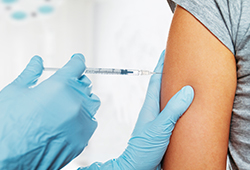 Investigators presented two studies on Monday at the American Society of Hematology Annual Meeting and Exposition (ASH) showing the potential for significant cost-savings by switching to biosimilar pegfilgrastim from the pegfilgrastim on-body injector (PEG-OBI).
Investigators presented two studies on Monday at the American Society of Hematology Annual Meeting and Exposition (ASH) showing the potential for significant cost-savings by switching to biosimilar pegfilgrastim from the pegfilgrastim on-body injector (PEG-OBI).
In one study, investigators demonstrated a potential for savings from a conversion to several biosimilar filgrastim and pegfilgrastim agents that could be reallocated to provide expanded access to prophylaxis or anti-neoplastic treatment of chemotherapy-induced febrile neutropenia (CIN/FN). Investigators simulated modeling for a panel of 20,000 non-Hodgkin lymphoma patients and calculated medication costs for reference pegfilgrastim with or without on-body injector (PEG/PEG-OBI), pegfilgrastim-cbqv and R-CHOP (cyclophosphamide, doxorubicin, vincristine, and prednisone plus rituximab) drugs.
They found that using the average selling price, cost-savings of biosimilar pegfilgrastim-cbqv over PEG/PEG-OBI ranged from $371,444 (for 1 cycle of prophylaxis at 10% conversion) to $22,286,640 (6 cycles at 100% conversion). Investigators estimate that “the savings over six cycles of biosimilar prophylaxis could provide between 1,690 (at 10% conversion) and 16,900 cycles (at 100% conversion) additional cycles of R-CHOP” and concluded that “significant cost savings for supportive cancer care can be generated through conversion to biosimilar pegfilgrastim-cbqv for CIN/FN prophylaxis.”
In the second study, investigators found that pegfilgrastim biosimilar as prophylaxis for chemotherapy-induced neutropenia has cost-savings and other advantages over pegfilgrastim delivered through an on-body injector. PEG-OBI has a reported failure rate of 1.7-6.9%, which investigators argued predisposes patient to increased risk of CIN/FN episodes. Investigators conducted a simulation analysis in a panel of 15,000 patients with diffuse large B-cell lymphoma (DLBCL) and concluded that, “taking incremental [FN-related hospitalizations] costs due to PEG-OBI failure into consideration, cost-savings in cycle one from conversion to PEG-jmdb, ranged from $406,118…to $5,674,454.” They concluded that biosimilar PEG-jmdb generates substantial cost savings in comparison to PEG-OBI, and “savings further increase when the costs of [FN-related hospitalizations] related to PEG-OBI failure are taken into account.”
